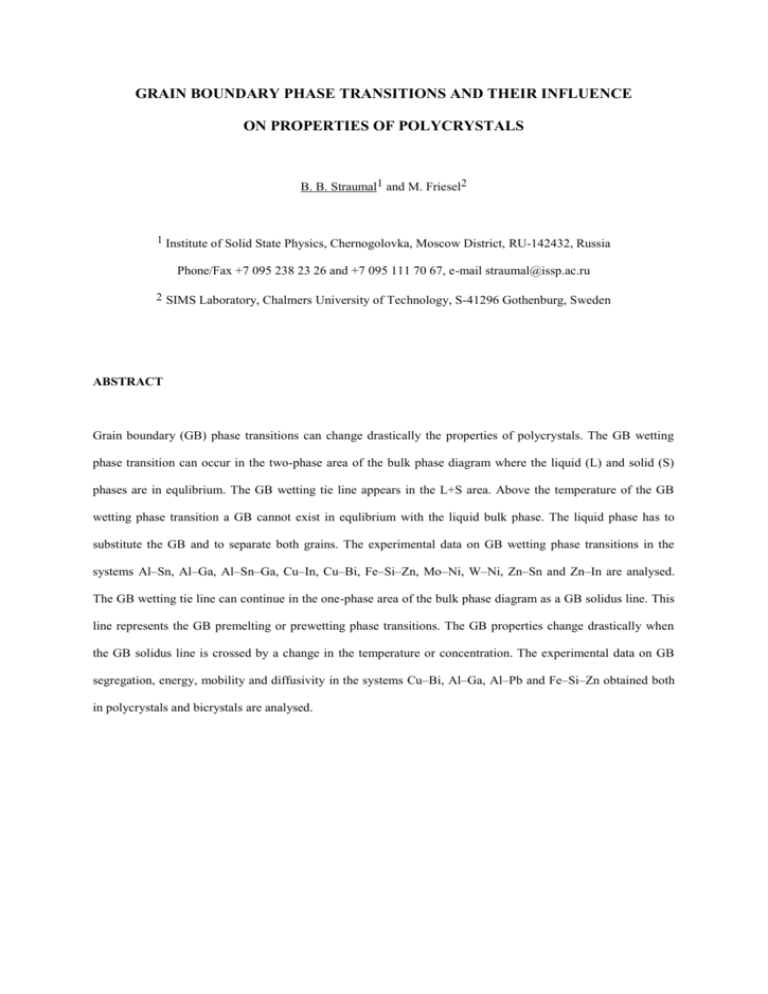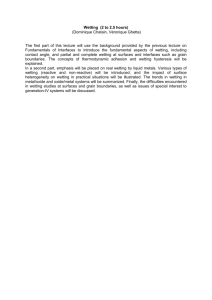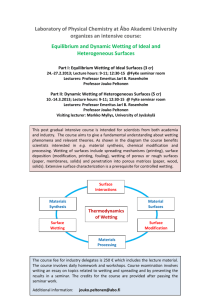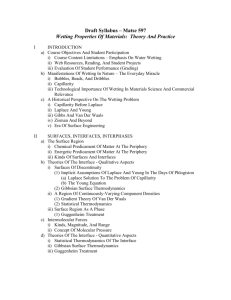Paper
advertisement

GRAIN BOUNDARY PHASE TRANSITIONS AND THEIR INFLUENCE ON PROPERTIES OF POLYCRYSTALS B. B. Straumal1 and M. Friesel2 1 Institute of Solid State Physics, Chernogolovka, Moscow District, RU-142432, Russia Phone/Fax +7 095 238 23 26 and +7 095 111 70 67, e-mail straumal@issp.ac.ru 2 SIMS Laboratory, Chalmers University of Technology, S-41296 Gothenburg, Sweden ABSTRACT Grain boundary (GB) phase transitions can change drastically the properties of polycrystals. The GB wetting phase transition can occur in the two-phase area of the bulk phase diagram where the liquid (L) and solid (S) phases are in equlibrium. The GB wetting tie line appears in the L+S area. Above the temperature of the GB wetting phase transition a GB cannot exist in equlibrium with the liquid bulk phase. The liquid phase has to substitute the GB and to separate both grains. The experimental data on GB wetting phase transitions in the systems Al–Sn, Al–Ga, Al–Sn–Ga, Cu–In, Cu–Bi, Fe–Si–Zn, Mo–Ni, W–Ni, Zn–Sn and Zn–In are analysed. The GB wetting tie line can continue in the one-phase area of the bulk phase diagram as a GB solidus line. This line represents the GB premelting or prewetting phase transitions. The GB properties change drastically when the GB solidus line is crossed by a change in the temperature or concentration. The experimental data on GB segregation, energy, mobility and diffusivity in the systems Cu–Bi, Al–Ga, Al–Pb and Fe–Si–Zn obtained both in polycrystals and bicrystals are analysed. 1. Introduction The properties of modern materials, especially those of superplastic, nanocrystalline or composite materials, depend critically on the properties of internal interfaces such as grain boundaries (GBs) and interphase boundaries (IBs). All processes which can change the properties of GBs and IBs affect drastically the behaviour of polycrystalline metals and ceramics [1]. GB phase transitions are one of the important examples of such processes [2]. Recently, the lines of GB phase transitions began to appear in the traditional bulk phase diagrams [2–7]. The addition of these equilibrium lines to the bulk phase diagrams ensures an adequate description of polycrystalline materials. 2. GB Wetting phase transition In this work GB wetting, prewetting and premelting phase transitions are considered. The GB melting, GB faceting transition and the "special GB – random GB phase transitions" are analyzed elsewhere [8–10].One of the most important GB phase transitions is the GB wetting transition. Since their prediction by Cahn [11] the study of wetting phase transitions has been of great experimental and theoretical interest, primarily for planar solid substrates and fluid mixtures [12–14]. Particularly, it was experimentally shown that the wetting transition is of first order, namely the discontinuity of the surface energy was measured and the hysteresis of the wetting behavior was observed [15, 16]. The important difference is that in case of GB wetting only two phases coexist, namely the liquid (melt) phase and the solid one containing the boundary between the misoriented grains. Therefore, the contact angle also depends only on two different surface energies (the GB energy GB and the energy of the solid/liquid interphase boundary SL) instead of three ones in the usual experiments: GB = 2 SL cos (/2). If GB < 2SL, the GB is incompletely wetted and the contact angle >0 (Fig.1a). At the temperature Tw of the GB wetting phase transition GB = 2SL, and at T Tw the GB is completely wetted by the liquid phase and = 0 (Fig.1b). If two GBs have different energies the temperatures of their GB wetting transitions will also differ: the lower GB, the higher Tw(Figs.1c and 1d). If the GB wetting phase transition is of first order, there is a discontinuity in the temperature derivative of the GB energy at Tw which is equal to [GB/T – (2SL)/T ] [11, 16]. If the GB wetting phase transition is of second order, GB/T = (2SL)/T at Tw. The theory predicts also the form of the temperature dependence (T) at TTw: it must be convex for a first order wetting transition [ ~ 1/2 where = (Tw–T)/Tw ] and concave for a second order wetting transition: ~ 3/2 [12]. Nowdays, the GB phase transitions of the second order were not observed experimentally. Consider the contact between a bicrystal and a liquid phase L. If the GB energy GB is lower than the energy of two solid/liquid interfaces 2SL, the GB is not completely wetted and the contact angle > 0 (Fig.1a). If GB > 2SL the GB is wetted completely by the liquid phase and = 0 (Fig.1b). If the temperature dependences GB(T) and 2SL(T) intersect, then the GB wetting phase transition proceeds at the temperature Tw of their intersection (Fig.1c). The contact angle decreases gradually with increasing temperature down to zero at Tw. At T > Tw the contact angle = 0 (Fig.1d). The tie line of the GB wetting phase transition appears at Tw in the two-phase region (S+L) of the bulk phase diagram. Above this tie line GBs with an energy GB cannot exist in equilibrium with the liquid phase. The liquid phase forms a layer separating the crystals. First indications of the GB wetting phase transitions were found by measuring of the contact angles in polycrystals [17]. Correct measurements were later perfomed using metallic bicrystals with iundividual tilt GBs in the Al–Sn (Fig. 2), Cu–In (Fig. 3) [4], Al–Pb–Sn [3, 18, 19], Al–Ga, Al–Sn–Ga [20, 21], Cu–Bi [5, 22, 23], Fe–Si–Zn [24–27], Mo–Ni [28], W–Ni [29] and Zn–Sn [7] systems. The tie-lines of the GB wetting phase transition were constructed basing on the experimental data [3, 4, 7, 18–29]. The difference in the GB wetting phase transition temperature was experimentally revealed for GBs with different energies [4, 18]. The precize measurements of the temperature dependence of the contact angle revealed also that the GB wetting phase transition is of the first order [18]. The indications of presence of the liquid-like phase along the dislocation lines were also found [23]. 3. GB prewetting and premelting phase transitions It was pointed out by Cahn [30] that, when the critical consolution point of two phases is approached, GBs of one critical phase should be wetted by a layer of another critical phase, and in the one-phase region of a phase diagram there should be a singularity connected with an abrupt transition to a microscopic wetting layer. We distinguish two possible situations: the first one, when a layer of the new phase is formed on the GB (prewetting transition), and the second one, when the GB is replaced by a layer of the new phase (premelting phase transition). At the prewetting transition the difference between two phases must be small, while at the premelting transition the wetting phase may differ from that of the bulk dramatically. The lines of the GB prewetting or premelting phase transitions appear in the one-phase areas of the bulk phase diagrams where only one bulk phase can exist in the thermodynamic equilibrium (e.g. solid solution, see Fig. 4). These lines continue the tie-lines of the GB wetting phase transitions and represent the GB solidus (Fig. 4). The thin liquid-like layer of the GB phase exists on the GBs between the bulk solidus and GB solidus in the phase diagram. During the GB premelting phase transition this layer appears abruptly on the GB by the intersection of GB solidus. As a result, the GB properties (diffusivity, mobility, segregation) change dramatically. The premelting transition has been revealed in the ternary Fe–Si–Zn system by measurements of Zn GB diffusivity along tilt GBs in the Fe–Si alloys [24–27]. It was found that the penetration profiles of Zn along GBs consist of two sections, one with a small slope (high GB diffusivity) at high Zn concentrations and one with a large slope (low GB diffusivity) at low Zn concentrations. The transition from one type of behavior to the other was found to occur at a definite Zn concentration cbt at the GB, which is an equilibrium characteristic of a GB and depends on the temperature. The GB diffusivity increases about two orders of magnitude which is an indication of a quasi-liquid layer present in the GBs at high Zn concentration. The line of GB premelting phase transition in the one-phase area of the bulk phase diagram continues the line of the GB wetting phase transion in the two-phase L+S area: by pressure increase both the GB wetting and the GB enhanced diffusivity disappear together at the same pressure value (Fig. 5) [27]. The GB mobility was studied for two tilt GBs in bicrystals grown of high purity 99.999 wt.% Al and of the same material doped with 50 wt. ppm Ga [21]. The GB mobility increased about 10 times by addition of the Ga content for the both GBs studied. Normally, the addition of a second component can only decrease the GB mobility due to the solution drag [31]. The increase of the GB mobility can only be explained by the formation of the liquid-like Ga-rich layer on the GBs as a reslut of a premelting phase transition The GB segregation of Bi in Cu was studied in the broad temperature and concentration interval [5, 22, 23]. It was shown that at a fixed Bi concentration the GB segregation change abruptly at a certain temperature. Below this temperature the GB Bi concentration is constant and corresponds to a thin layer of pure Bi (GB phase). Above this temperature the GB segregation is lower than one monolayer of Bi and decreases gradually with increasing temperature according to the usual laws. These features indicate also the formation of a thin layer of a GB phase in the one-phase area of the bulk Cu–Bi phase diagram. The points of the abrupt change of the GB segregation form the GB solidus line in the bulk Cu–Bi phase diagram [22, 23]. Acknowledgements The financial support of the Royal Swedish Academy of Sciences under the programme for cooperation between Sweden and the former Soviet Union and the INTAS Programme (under contract 99-1216) is acknowledged. REFERENCES [1] T. G. Langdon, T. Watanabe, J. Wadsworth, M. J. Mayo, S. R. Nutt and M. E. Kassner, Mater. Sci. Eng. A 166 (1993) 237. [2] B. B. Straumal and W. Gust, Mater. Sci. Forum 207–209 (1996) 59. [3] B. Straumal, D. Molodov and W. Gust, J. Phase Equilibria 15 (1994) 386. [4] B. Straumal, T. Muschik, W. Gust and B. Predel, Acta metall. mater. 40 (1992) 939. [5] L.-S. Chang, E. Rabkin, B. B. Straumal, S. Hofmann, B. Baretzky and W. Gust, Defect Diff. Forum 156 (1998) 135. [6] B. Straumal, V. Semenov, V. Glebovsky and W. Gust, Defect Diff. Forum 143–147 (1997) 1517. [7] B. B. Straumal, W. Gust and T. Watanabe, Mater. Sci. Forum 294–296 (1999) 411. [8] F. Ernst, M. W. Finnis, A. Koch, C. Schmidt, B. Straumal and W. Gust, Z. Metallk. 87 (1996) 911. [9] B. B. Straumal and L.S. Shvindlerman, Acta metall. 33 (1985) 1735. [10] E. L. Maksimova and L. S. Shvindlerman, B. B. Straumal, Acta metall. 36 (1988) 1573. [11] J. W. Cahn, J. Chem. Phys. 66 (1977) 3667. [12] S. Dietrich, In: Phase Transitions and Critical Phenomena, edited by C. Domb and J. H. Lebowitz, vol. 12, (Academic, London, 1988), p.2. [13] D. Jasnov, Rep. Prog. Phys. 47 (1984) 1059. [14] G. de Gennes, Rev. Mod. Phys. 57 (1985) 827. [15] H. Kellay, D. Bonn and J. Meunier, Phys. Rev. Lett. 71 (1993) 2607. [16] J. W. Schmidt and M. R. Moldover, J. Chem. Phys. 79 (1983) 379. [17] N. Eustatopoulos, L. Coudurier, J. C. Joud and P.Desre, J.Crystal Growth 33 (1976) 105 [18] B. Straumal, W. Gust and D. Molodov, Interface Sci. 3 (1995) 127. [19] B. Straumal and D. Molodov, W. Gust, Mater. Sci. Forum 207–209 (1996) 437. [20] B. Straumal, S. Risser, V. Sursaeva, B. Chenal and W. Gust, J. Physique IV 5-C7 (1995) 233. [21] D. A. Molodov, U. Czubayko, G. Gottstein, L. S. Shvindlerman, B. B. Straumal and W. Gust, Phil. Mag. Lett. 72 (1995) 361. [22] L.-S. Chang, B. B. Straumal, E. Rabkin, W. Gust and F. Sommer, J. Phase Equilibria 18 (1997) 128. [23] L.-S. Chang, E. Rabkin, B. Straumal, P. Lejcek, S. Hofmann and W. Gust, Scripta mater. 37 (1997) 729. [24] E. I. Rabkin.V. N. Semenov, L.S. Shvindlerman and B.B. Straumal, Acta metall. mater., 39 (1991) 627. [25] O. I. Noskovich, E. I. Rabkin, V. N. Semenov, L. S. Shvindlerman and B. B. Straumal, Acta metal. mater. 39 (1991) 3091. [26] B. B. Straumal, O. I. Noskovich, V. N. Semenov, L. S. Shvindlerman, W.Gust and B. Predel, Acta metall. mater. 40 (1992) 795. [27] B. Straumal, E. Rabkin, W. Lojkowski, W. Gust and L. S. Shvindlerman, Acta mater. 45 (1997) 1931. [28] E. Rabkin, D. Weygand, B. Straumal, V. Semenov, W. Gust and Y. Brèchet, Phil. Mag. Lett. 73 (1996) 187. [29] V. G. Glebovsky, B. B. Straumal, V. N. Semenov, V. G. Sursaeva and W. Gust, High Temp. Mater. Proc. 13 (1994) 67. [30] J. W. Cahn, J. Phys.Colloq. 43-C6, 1982, 199. [31] D. Weygand, Y. Bréchet, E. Rabkin, B. Straumal and W. Gust, Phil. Mag. Lett. 76 (1997) 133. L SL S SL L GB S (b) (a) SL (c) (d) GB1 GB2 0 Temperature T w1 Tw2 Temperature Tw1 Tw2 Fig. 1. (a) Scheme of the equilibrium contact between the grain boundary in the solid phase S and the liquid phase L (incomplete wetting). (b) Complete GB wetting. (c) Scheme of the temperature dependence for the GB energy GB (for two different GBs) and the energy of the solid-liquid interface boundary SL. (d) Scheme of the temperature dependence of the contact angle for thwo grain boundaries with energies GB1 and GB2. Tw1 and Tw2 are the temperatures of the GB wetting phase transition. at. % Sn 0 10 20 40 60 80 100 L Tw2 T,°C 600 T w1 400 (Al)+L 200 (Sn) (Al) 0 Al 20 40 60 wt. % Sn 80 100 Sn Fig. 2. The Al–Sn phase diagram. Thick solid lines represent the bulk phase transitions. Thin solid lines are the tie lines of the GB wetting phase transitions. Thin dotted represent the estimation for the GB wetting phase transiton for the GB with highest possible energy. T,°C 1000 Tw2 L 800 600 Tw1 (Cu)+L (Cu) 400 200 (In) 0 0 Cu 20 40 60 at.% In 80 100 In Fig. 3. The Cu–In phase diagram. Thick solid lines represent the bulk phase transitions. Thin solid lines are the tie lines of the GB wetting phase transitions in the (Cu)+L two phase area. T Tm L Tw2 Tw1 S A S+L at. % B Fig. 4. Scheme of the phase diagram with lines of bulk and GB phase transitions. Thick solid lines represent the bulk phase transitions. Thin solid lines represent the tie lines of the GB wetting phase transition in the S + L area for the high angle GBs having maximal and minimal possible energy. Thin dotted lines represent the GB premelting phase transition proceeding in the area where only the solid solution is stable in the bulk. T, °C 1,5 p, GPa 1,0 1000 c 0 0,5 900 c bt 800 700 c 600 bt c 0 0 5 10 15 c , at.% Zn Fig. 5. The (Fe – 5 at. % Si) – Zn phase diagram showing the influence of temperature T and pressure p. Thick solid lines represent the bulk phase transitions. Thin solid lines cbt(T, p) are the tie lines of the GB premelting phase transition.







